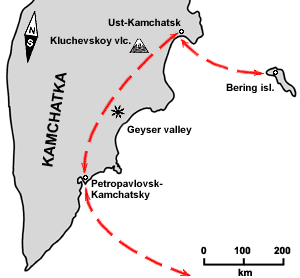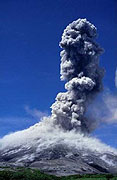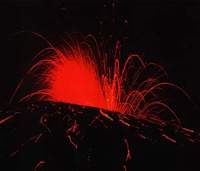
Grade
of difficulty: easy (sightseeing
)
Land
cost: $2950 per person in a
group of 6.
The
price includes: helicopter charter expenses,
insurance, all overland transport expenses on the islands,
English-speaking guide service, kitchen crew, all the meals,
camp stuff and tents.
Domestic flight (if any) airfare, Russian visa,
over luggage if any, personal expenses, tips and medical insurance
are not included.
Highlights:
- explore
preserved wildlife area of the Komandors,
- watching the biggest colony of fur seals
on the Western Pacific Coast,
- experiencing the bird-watching at the
important migration spot in the Pacific basin.
- visiting
the museum of the Regional Studies, the Vitus Bering grave
and the other historical places.
|
The
Komandorsky Islands are one of the most preserved areas of
the Kamchatka Region. They are included into the Koman- dorsky
State Natural Reserve. There are two large islands: the Bering
and the Medny and two small ones: the Ariy Kamen’ and the
Toporkov.
The Bering Island stretches from north-west to south-east
for 75 km. The landscape of its northern part is rather smooth
and flattened. It’s possible to walk along the shore line
almost everywhere. The south of the island is mountainous.
The island was named after the leader of two Kamchatkan expeditions
of the XVIII century, the navigator captain-commander Vitus
Bering, who had been living there together with crew of the
ship “St. Peter” for 9 months and died of scurvy.
The Medny Island was named after a serving man Dmitry Nakvasin,
who had found there a native copper (“medny”- means copper)
in 1743. It looks as waves of dark-green slopes in summer
and white – in winter, beyond which there are mountains. All
these mountains and tundra are surrounded by shore-walls with
small bays scattered here and there. On summits of hill-waves
there is lichen, below there are berry-fields, rhododendrons.
In river valleys there are dense grass and low-growing bushes.
Northern fur seals are undoubtedly the main sight and wealth
of the Komandorsky Islands. In late April the first male adults
appear on seal-rookeries. Fur seals hibernate near the Japanese
Islands and having spent there severe seasons come back to
native places. Thousands of them occupy the northern and north-west
parts of the Bering Island.
Arctic blue foxes are hosts of the islands. In the southern
part of the Bering Island there is a small reindeer
herd, which had been brought there from Kamchatka twice before
adapted to new food. Rivers of the Islands are spawning grounds
for Pacific salmon. The main spawning ground is large Sarannoe
Lake. Sea giants or whales inhabit waters along the Komandorsky
Islands shores.
5
days, 4 nights
|


